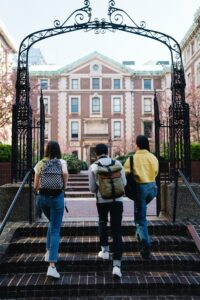Making the most of fall campus visits

Most families wait until the spring of a student’s junior year to begin the college visit process.
I’d like to suggest that you take a serious look at your high school calendar and identify “teacher work days.” They usually fall in early autumn, and typically at the end of the first quarter or trimester and then again after first semester.
These are fabulous times to visit colleges because you know they’ll be in session and there won’t be monstrous crowds. One of the other reasons I encourage these visits is because students can check in with college freshmen who attended their high school and get some honest feedback on academics, social life, and adjustment to college life.
It is my strong recommendation that students don’t visit colleges blindly. The most fruitful campus visits begin with advance research. This means the student has already determined why the college is of interest to them both academically and socially. I ask my students to complete a “College Fit Worksheet” (CFW) where they take a virtual tour, read a college guidebook, visit the college website, read student reviews, look at a course catalog; enough homework so that they can articulate “Why they’re interested in visiting.” The last question on the CFW is – “is this school worthy of a campus visit, if so, why or why not?” The “Why nots” are really interesting because they’re sharing what they’ve learned and often dispelling myths and stereotypes.
Campus visits can be great bonding time with families, but they can also be stressful. Try to organize your fall trips where you’re utilizing the teacher workdays and not seeing more than two schools per day.
There are three main types of campus visits that you should be aware of, prior to planning:
Open Houses – sometimes referred to as “Discover Days.” This is where there is typically a large crowd and a specific itinerary. Often colleges permit high school students to sit in on classes of interest and frequently there is a panel of admissions offices and a panel of students where you can ask questions. These visits are a great way to see a college for the first time. The college is prepared, and even the food in the dining halls is upgraded! In short, the college is putting its best face forward. You’ll learn a lot, but it won’t be a very personalized visit.
Overnight Visits – I recommend overnight visits especially when a student is considering applying Early Decision. Overnight visits can be a great opportunity to see the facilities first-hand, shadow a student by attending classes and socialize with current students. Students and families can reach out to a friend and do this independently from the admissions office. Many colleges are willing to assist in arrangements. However, I want to caution families that these visits can be risky. I’ve had students who were totally committed to a college, and when they visited a friend there, they found themselves overwhelmed with the partying and then left feeling disheartened.
Traditional Campus Visit – The traditional campus visit has two components: an information session led by a representative from the Admissions Office and a campus tour, led by student ambassadors. These visits are a great introduction to the college or university. Many schools have created engaging videos that review all the topics of interest: admissions stats, number of majors, variety of student organizations and clubs, housing, and security, etc., there’s lots to learn. Seasoned admissions representatives will answer questions and then families break into groups for the campus tour. The size of the group for campus tours can vary widely from a small handful to 30+ visitors and that can affect the take-away thoughts. Traditional campus visits are a great introduction, but if the tour is not what you had hoped for, try to put it in perspective and don’t remove the school from your list.
Bierer is an independent college adviser based in Charlotte. Send questions to: lee@bierercollegeconsulting.com; www.bierercollegeconsulting.com
